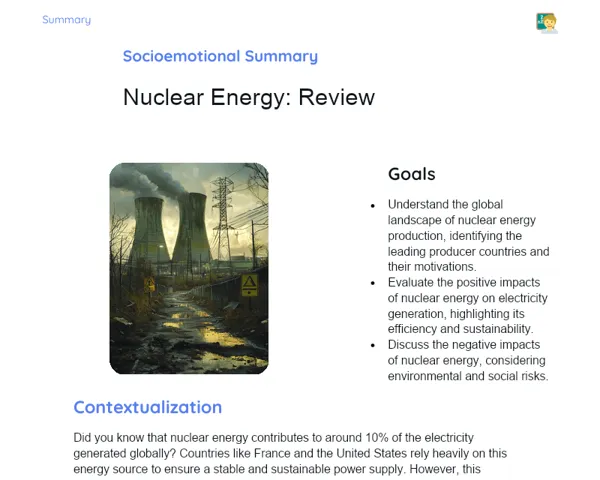Objectives
1. Identify and describe the main types of rocks (igneous, sedimentary, and metamorphic) and their distinctive characteristics.
2. Understand how the formation and presence of these types of rocks influence the geographical landscape.
3. Inspire students' curiosity about the geological processes involved in rock formation.
4. Encourage students to observe carefully and analyze geological materials critically.
Contextualization
Did you know that the rocks we encounter can be millions of years old? They are not mere stones; they are historical storytellers of our Earth. For instance, sedimentary rocks often contain fossils that provide insights into the evolution of life on our planet. Moreover, the formation of mountains, valleys, and even the quality of the soil in our fields are directly influenced by the types of rocks found in the area. Hence, studying rocks goes beyond geology; it's about understanding the historical paths and natural processes that have shaped our Earth as we see it today.
Important Topics
Igneous Rocks
Igneous rocks form when magma (molten rock) cools and solidifies. These rocks can be found either on the Earth's surface and termed extrusive (or volcanic) or within the crust, known as intrusive. Examples of igneous rocks include basalt, granite, and diorite, each showcasing distinct physical and chemical properties due to their unique formation processes.
-
Basalt: A common igneous rock, formed from lava that cools rapidly on the surface, resulting in a fine and usually dark texture.
-
Granite: Typically found as intrusive rocks, formed slowly beneath the Earth’s surface, leading to a coarse texture with a composition rich in minerals like quartz and feldspar.
-
Economic Importance: Igneous rocks, especially granite, are highly valued in construction and sculpture due to their strength and aesthetic appeal.
Sedimentary Rocks
Sedimentary rocks form from deposited sediments that compact and solidify over time. These sediments can comprise fragments of other rocks, fossilized remains, and dissolved minerals. Common examples include sandstone, limestone, and shale, reflecting the environmental conditions during their formation.
-
Sandstone: Primarily formed from quartz grains moved by wind or water and settled in layers.
-
Limestone: Mostly composed of calcium carbonate, often derived from shells of marine organisms that accumulate at the seabed.
-
Archaeological Importance: Sedimentary rocks frequently contain fossils, which are crucial for piecing together the history of life on Earth.
Metamorphic Rocks
Metamorphic rocks are those that have been transformed physically and chemically due to high pressure and temperature, without melting. Such conditions often arise at significant depths within the Earth’s crust, especially during tectonic plate movements. Examples include slate, gneiss, and marble, each revealing unique textures and compositions from their metamorphic origins.
-
Slate: A metamorphic version of shale, characterized by its ability to split into thin layers, commonly used for roofing and as writing material.
-
Gneiss: Formed through the metamorphism of igneous and sedimentary rocks, showcasing colored bands, often used decoratively.
-
Marble: Originating from the metamorphism of limestone, marble has a crystalline texture and is widely appreciated in sculptures and architectural elements for its elegance and polish.
Key Terms
-
Igneous Rocks: Rocks formed from the cooling and solidification of magma.
-
Sedimentary Rocks: Rocks formed from the deposition and compaction of sediments.
-
Metamorphic Rocks: Rocks that have been altered by high pressure and temperature without melting.
For Reflection
-
How do the various types of rocks found in a region influence the vegetation and development of local communities?
-
In what ways can rock studies assist in predicting and monitoring natural disasters like earthquakes and landslides?
-
Why is it important to understand igneous, sedimentary, and metamorphic rocks in fields like construction and urban planning?
Important Conclusions
-
Today, we journeyed into the Earth’s interior to unravel the mysteries of rocks and their captivating stories. We explored the three main types of rocks — igneous, sedimentary, and metamorphic — learning about their formation and how they impact our surrounding landscape.
-
We uncovered that rocks are more than mere stones; they record the geological and climatic events that have sculpted our planet over countless years.
-
We examined the physical and chemical properties that distinguish each rock type, such as texture, mineral content, and formation location, and explored their significant implications in various practical applications, from construction to environmental conservation.
To Exercise Knowledge
- Rock Collector: During the week, gather at least three samples of different rocks. Try to identify each rock type and describe its visual and tactile characteristics. 2. Rock Map: Draw an imaginary map of an island, indicating where you think specific types of rocks could be found, and justify your choices based on geological reasoning. 3. Geologist's Diary: Select a rock type and compose a fictional diary entry as if you were that rock, detailing its formation and adventures over millions of years.
Challenge
🌍 Junior Geologist Challenge: Apply your newfound knowledge to create a small field guide about rocks for your friends and family. Include images and descriptions of common rocks found in your vicinity and explain how they were formed. Present your guide in the next class, and we can discuss your observations!
Study Tips
-
Visit a natural history or geology museum to observe real rocks and fossils, and try identifying different types of rocks you've learned about.
-
Watch documentaries on geology and rock formations to see real-world instances and enhance your understanding of geological processes.
-
Utilize online resources for rock identification practices to reinforce your knowledge about rock characteristics.



